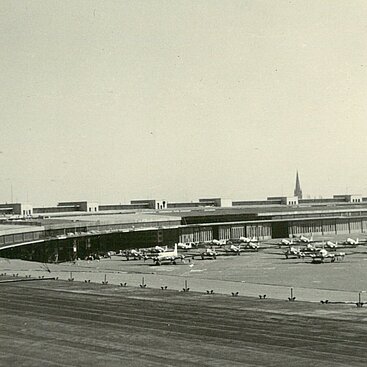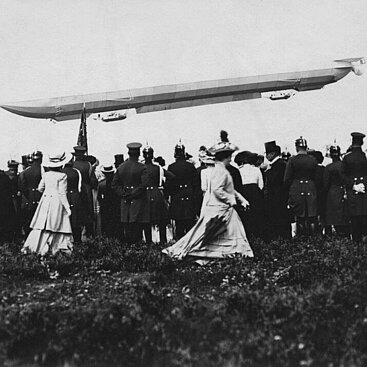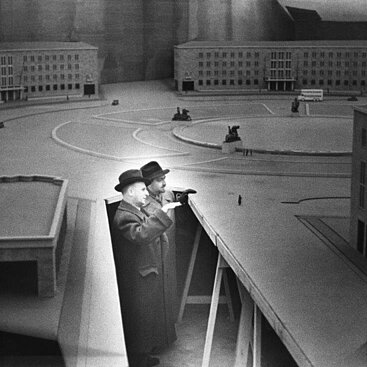Gateway to the World
When Airport Tempelhof is often referred to as “Berlin’s Gateway to the World”, it primarily means the airlift that linked West Berlin with the western zones and the rest of the world. It has especially characterised the history of the trapped West Berlin as an identity-creating event.
The airport that was no longer a hub since 1945 was considered the “Gateway to the World” from the period of the airlift up to the first closure in 1975 in its double capacity: as the only unhindered transport link with the outside world and as a stage for the international prominence from films, fashion and politics penetrating West Berlin.
The airlift became a symbol
It was the airlift that had “radically changed the international position of Germans. Almost overnight Berlin turned from a symbol for Prussianism and National Socialism into a symbol for freedom against threats. The threats were real - but just as real as pleasant gratification suddenly being on the “good” side.....”. As phrased by the publicist Alfred Grosser, who had to immigrate to France in 1933 as a child along with his parents.
Between the years of construction and reconstruction, Airport Tempelhof stood for hope of West Berlin to become a metropolis again and to move on from the affliction of the NS period. Wartime destructions, division of country, political uncertainty, island position, economic difficulties, disappearance of sales markets in surrounding area, relocation of productions and company headquarters in Federal Republic, increasing dependence on subsidies and finally construction of the Wall present the picture of a rather weak city. In the stress ratio between loss of importance and effort to create added value, the airport served as a transmission belt and projection surface in equal measure.
Tempelhof as transport link
At the end of the airlift, the civil transport resumed gradually. On 1 June 1950, the Berlin Senate received a small part of the airport for the development and administration of West Berlin air traffic. After the expansion and adaptation, the US Major General Mathewson officially handed over the new facility with control tower at the southern end of the hangar to the re-established Berliner Flughafengesellschaft (BFG) in 1951. Mayor Ernst Reuter, who had inaugurated the civil airport on 9 July 1951, remarked in a conversation with the Tagesspiegel: “There are now even fewer excuses to not come to Berlin” (10.7.1951)
Each airline of the Allied Forces carried out the entire air transport. German pilots were not permitted. Pan American flew from USA in Berlin transport; after 1950, even Air France offered scheduled flights to and from Berlin. British European Airways finally relocated in 1951 from Gatow to Tempelhof; the Gatow airfield was continued as a military airport. In 1954 Pan Am undertook the first intercontinental direct flight from New York to Berlin with stop-overs in Prestwick and Hamburg; the duration of the flight DC-6 was more than 17. Before Frankfurt am Main, Hamburg and Düsseldorf, Tempelhof moved up the ladder to become the most frequented airport. Soon it occupied third place in Europe in terms of passenger volume outnumbered only by London and Paris. Not before the end of 1950s, with the beginning of jet aircraft transport, Frankfurt am Main surpassed it as the new international hub.
In 1950s, BFG enlarged its land contingent with hangars for freight yard and customs clearance. In 1959 the US Air Force permitted the use of the large check-in hall, forecourt and the neighbouring building. BFG now operated almost half the airport; all the area to the east of the large check-in hall was used by the US up to 1993. Although Air France had already headed for airport Tegel with jet aircrafts in 1960 and for the first time it was apparent that Tempelhof had reached its capacity limit, West Berlin continued construction. In July 1962, the Mayor Franz Amrehn inaugurated the large hall.
The flight from Tempelhof offered the only opportunity to avoid tiresome procedures of transit traffic between West Berlin and the federal territory. For the refugees from GDR, this was the only safe connection to West Germany and abroad in decades. “Children airlift” also started from Tempelhof, which brought children from deprived families and GDR refugee families for a holiday in the Federal Republic.
Tempelhof as a stage
Prominent Berlin visitors generally did not travel in inter-zone trains; they flew in. The island position of West Berlin and the particularly tedious conditions of reconstruction made the Airport Tempelhof appear as an epitome of city life with representative halls, modern design and city atmosphere. The staging of the glide-in, opening of aircraft door, descending to the gangway on the airfield, camera flashlights and jubilant fans countered the soberness of West Berlin routine with long-lost “glamour” of a metropolis.
The focus of public interest was on prominent film stars and directors, who travelled to Berlinale every year. The West Berlin festival was established in 1951 at the initiative and with the support of the US Allied forces under the motto “Window of the free world” and could hold its own against the Cannes and Venedig Festivals since 1954. In the 1950s, the summer festival days mainly painted a picture of the city with jubilant crowd at the airport, in front of hotels and performance venues with Corsica cars, bouquets and large placards. The photos of these years show Who’s Who of the western film world upon their arrival in Tempelhof. The same goes for the stars of fashion world. The confection and fashion industry largely destroyed by National Socialism and traditionally anchored in Berlin was officially actively promoted in the post-war period and found large appearances on gangways and in the arrival hall. Even politicians although less spectacular as well as the scale of show business and rock and pop, i.e. Rolling Stones before their concert in Waldbühne in 1965, painted a picture of the airport to date in public memory.
And finally Tempelhof served as a cinematic stage of Cold War. Especially Billy Wilder’s films “A Foreign Affair” (1948), which began with the arrival of a young congressman on the airfield, and his Berlin satire “One, Two, Three” (1961) sent pictures of “Berlin’s Gateway to the World” all over the world. Will Tremper’s film “The endless night” (1962) made the architecture of the airport a timeless existential transit, to whose real model West-Berlin reluctantly bid goodbye in September 1975.
The conversion of the international airlines to jet aircrafts brought an end to Tempelhof. While Air France landed on the provisional Tegel airport due to its longer runway as of 1960 with “Caravelle”, Pan American Airways with three-jet Boeing 727 and British European Airways with two-jet BAC 1-11 continued to use Airport Tempelhof. As the jet aircrafts were also used for holiday flights, Western Allied Forces and BFG decided to relocate the charter company to Tegel in 1968. Rapidly increasing number of passengers, increase in aircraft noise, lack of parking spaces: Various signs indicated the approaching capacity limit of the city airport. Nevertheless the large check-in hall was reconstructed once more in 1970 and set up for 6 million passengers per year - a utilisation that was very close to achieving in 1971. For the year of 1974, forecasts promised an increase to 7 million passengers in Berlin air traffic. A continuous increase in mass tourism could be expected because for the same year an opening of the new facility in Southern Tegel was planned.
In reality, the West Berlin air traffic was still transit traffic for a critical part. With the agreement between the senate and government of GDR about the trips to and from West Berlin, the passenger volume dropped in 1972. Since the GDR government set up extensive invasive checks, the cheaper road and train journeys became more appealing. Four years after the transit agreement came into force in the middle of recession caused by the oil crisis, only fewer than four million passengers were counted. The question of how the shrinking demand for both West Berlin airports is distributed was disputed over vehemently. To avoid competitive disadvantages resulting from remote area, Pan Am and British Airways finally switched to Tegel airport with financial support of the Senate. The civil airport of Tempelhof is closed; in future, it will only be available for special and training flights was well as in case of emergencies.
St. Endlich, M. Geyler-von Bernus, B. Rossié
Literature
Alfred Grosser, the capital Berlin: The symbolism, reality and Europa of values. In: Werner Süß, Ralf Rytlewski (editor), Berlin. The capital. Past and future of a European metropolis, Berlin 1999
Wolfgang Jacobsen, 50 years of Berlinale International Film Festival of Berlin, Berlin 2000
Frank Schmitz, Airport Tempelhof. Berlin’s Gateway to the World, Berlin 1997
Michael Thiele, The conquest of the skies, in: District Office of Tempelhof, Berlin (editor), Landing on Tempelhof. 75 years of central airport – 50 years of airlift, exhibition catalogue, Berlin without date specification (1998)





